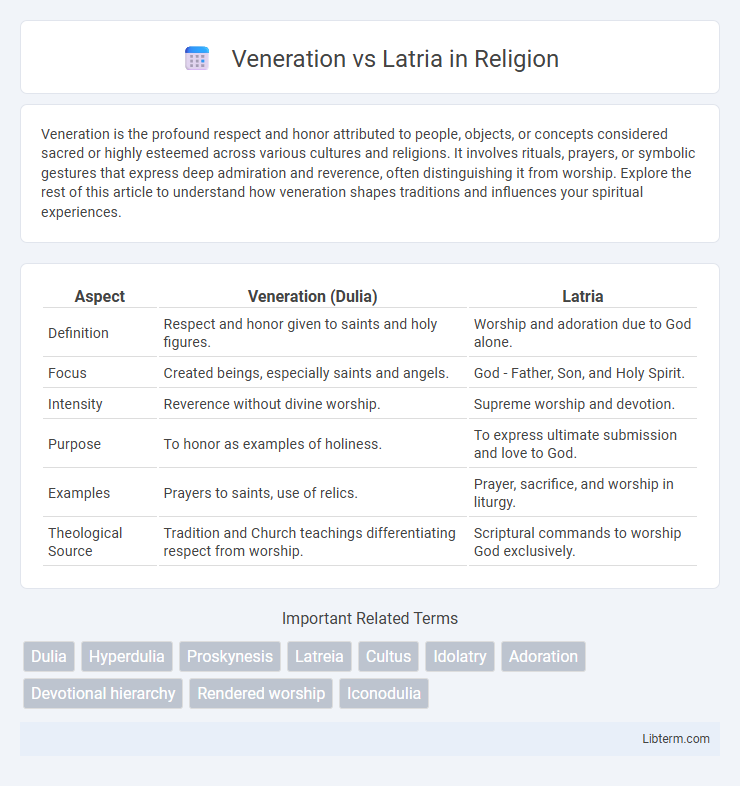Veneration is the profound respect and honor attributed to people, objects, or concepts considered sacred or highly esteemed across various cultures and religions. It involves rituals, prayers, or symbolic gestures that express deep admiration and reverence, often distinguishing it from worship. Explore the rest of this article to understand how veneration shapes traditions and influences your spiritual experiences.
Table of Comparison
| Aspect | Veneration (Dulia) | Latria |
|---|---|---|
| Definition | Respect and honor given to saints and holy figures. | Worship and adoration due to God alone. |
| Focus | Created beings, especially saints and angels. | God - Father, Son, and Holy Spirit. |
| Intensity | Reverence without divine worship. | Supreme worship and devotion. |
| Purpose | To honor as examples of holiness. | To express ultimate submission and love to God. |
| Examples | Prayers to saints, use of relics. | Prayer, sacrifice, and worship in liturgy. |
| Theological Source | Tradition and Church teachings differentiating respect from worship. | Scriptural commands to worship God exclusively. |
Understanding Veneration and Latria
Understanding veneration and latria involves recognizing their distinct roles in religious practice. Veneration refers to the respectful honor given to saints and holy objects, acknowledging their exemplary faith and intercessory power without equating them to divinity. Latria, on the other hand, is the worship and adoration reserved exclusively for the divine nature of God, emphasizing the fundamental distinction between honoring saints and worshiping God in Christian theology.
Historical Origins of the Terms
The terms "Veneration" and "Latria" originate from early Christian theological distinctions regarding the honor due to saints versus God. "Latria" derives from the Greek latreia (latreia), meaning "worship" or "service," reserved exclusively for God, while "Veneration," from the Latin veneratio, refers to reverence shown to saints and holy objects. These distinctions were formalized during the early Ecumenical Councils, particularly the Second Council of Nicaea in 787 AD, which clarified proper worship practices to combat iconoclasm.
Key Differences Between Veneration and Latria
Veneration involves honoring saints and holy objects with deep respect, while latria is reserved exclusively for the worship and adoration of God alone. The key difference lies in the object of reverence: veneration acknowledges the sanctity of created beings, whereas latria expresses supreme divine worship. Understanding this distinction clarifies practices in Christian theology, especially within Catholic and Orthodox traditions.
Theological Foundations of Veneration
Veneration, distinguished from latria, is the respectful honor given to saints and holy objects, grounded in the theological principle that worship is due to God alone. The Church Fathers emphasize that veneration acknowledges the sanctity and exemplary faith of saints while maintaining clear ontological distinctions between Creator and creature. This theological foundation safeguards the integrity of divine worship, ensuring that veneration cultivates spiritual reverence without diverting adoration from the sole deity.
The Concept of Latria in Christian Doctrine
Latria in Christian doctrine signifies the highest form of worship and adoration reserved exclusively for God, distinguishing it from veneration given to saints or holy objects. This concept emphasizes God's supreme divinity and unique worthiness of absolute devotion, reflecting core Trinitarian theology. Understanding latria is essential for maintaining theological clarity in worship practices and safeguarding against idolatry within Christian liturgy.
Veneration in Practice: Saints and Relics
Veneration in practice involves honoring saints and relics as sacred symbols that inspire faith and devotion without equating them to divine worship. This form of reverence recognizes the saints' exemplary holiness and their intercessory role, distinct from latria, which is reserved exclusively for God. Religious ceremonies often include prayers, processions, and the display of relics, emphasizing respect and spiritual connection rather than adoration.
Latria: Worship Given to God Alone
Latria is the highest form of worship reserved exclusively for God, expressing adoration and supreme reverence in Christian theology. Unlike veneration, which honors saints and sacred objects with respect and devotion, latria signifies absolute worship that acknowledges God's divine sovereignty and holiness. This distinction emphasizes that latria is reserved solely for the Holy Trinity, safeguarding the unique dignity and exclusivity of divine worship.
Misconceptions and Common Confusions
Veneration and latria are often confused due to their similar expressions of reverence, but latria specifically refers to the worship reserved for God alone, while veneration is the honor given to saints and holy objects. Misconceptions arise when veneration is mistaken for idolatry, leading to debates about the appropriateness of honoring saints versus worshiping God. Understanding the theological distinction clarifies that veneration supports faith without crossing into the divine adoration characterized by latria.
Veneration and Latria in Eastern and Western Traditions
Veneration (proskynesis) in Eastern Orthodox tradition emphasizes honor given to icons and saints without equating it to the worship reserved exclusively for God, known as latria. Western Catholicism distinguishes latria as the adoration due to the Holy Trinity alone, while veneration (dulia) is directed toward saints and holy objects, maintaining clear theological boundaries. This nuanced differentiation allows Eastern and Western churches to preserve monotheistic worship centrality while expressing reverence within their distinct liturgical practices.
Modern Relevance and Contemporary Debates
Veneration, distinguished from latria by its relative reverence toward saints and sacred objects rather than God alone, remains a pivotal concept in modern theological discourse, especially within Catholic and Orthodox communities. Contemporary debates often explore its relevance in interfaith dialogues, addressing misunderstandings about idolatry and emphasizing respectful honor without equating it to divine worship. This distinction shapes practices in liturgy, iconography, and religious education, influencing how devotion is expressed and perceived in an evolving spiritual landscape.
Veneration Infographic

 libterm.com
libterm.com